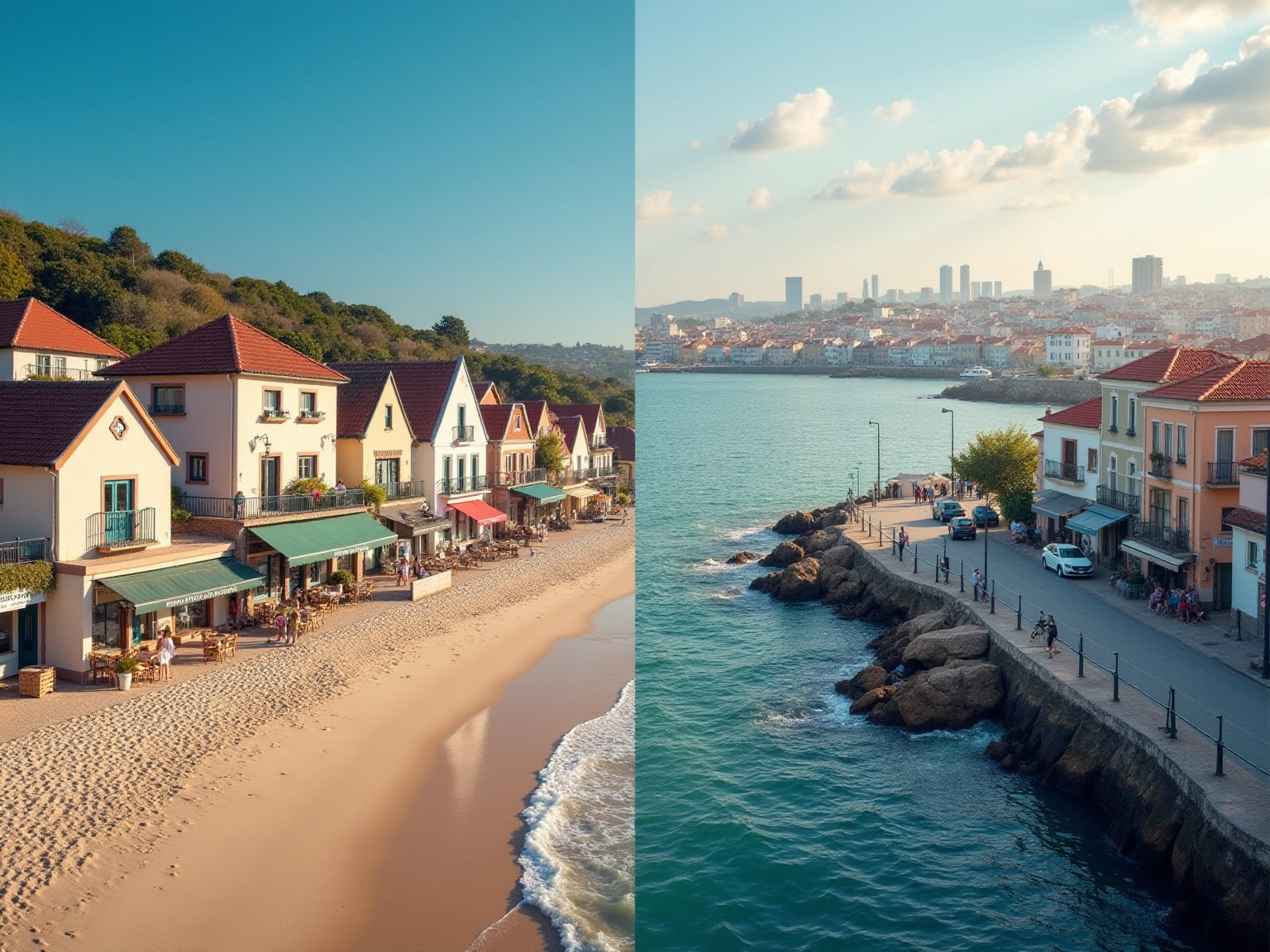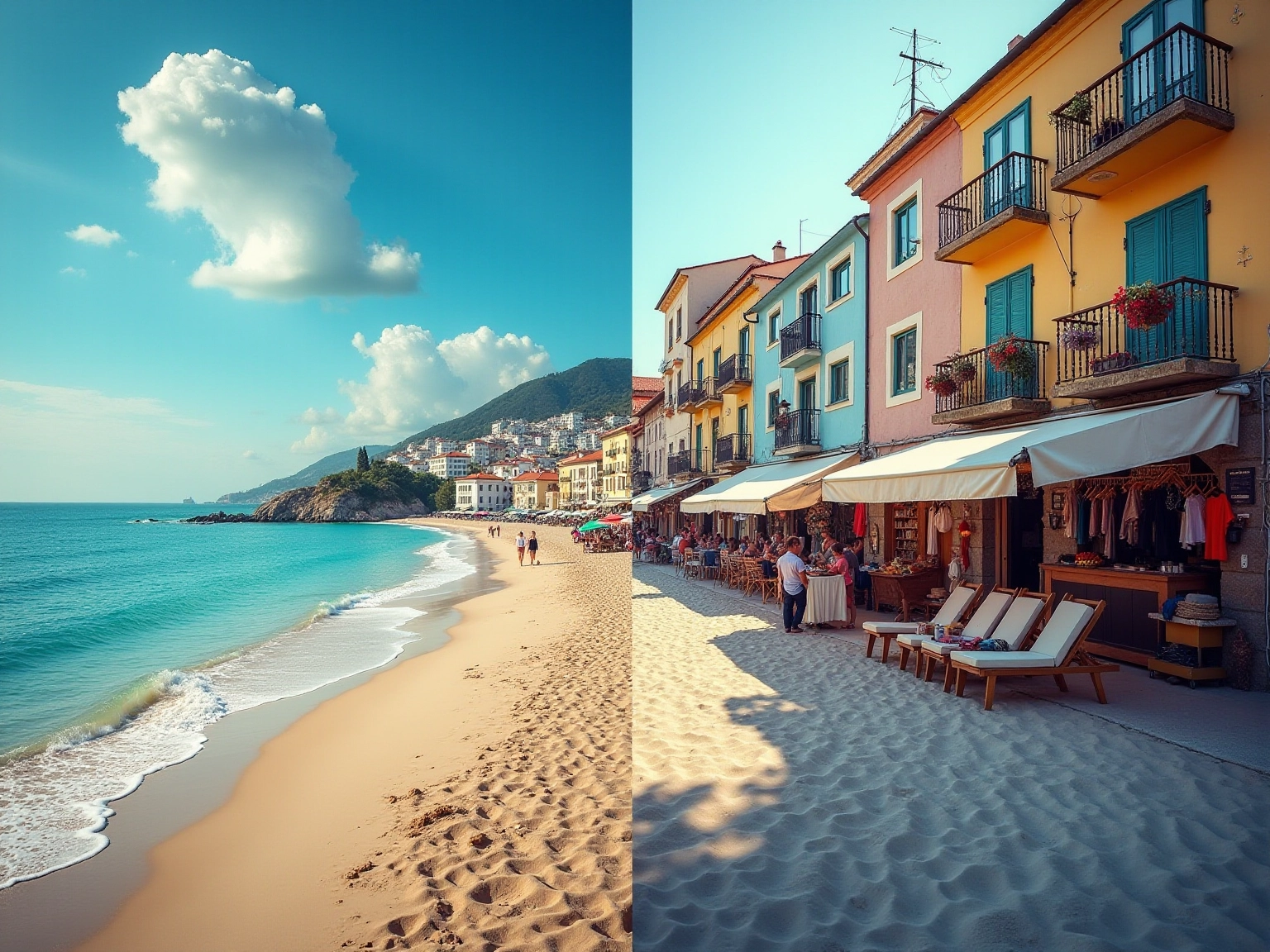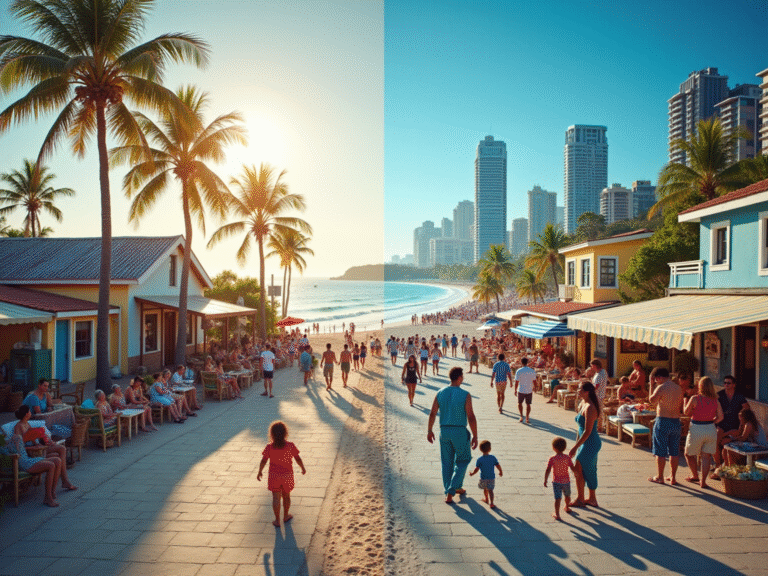Overview
This article dives into the delightful comparison between beach villages and coastal cities, showcasing their unique characteristics and the experiences they bring to life! You’ll find that beach villages offer a serene, close-knit community vibe, rich in cultural authenticity. On the flip side, coastal cities buzz with vibrant urban energy, packed with diverse amenities and activities!
So, which one is right for you? It really comes down to your personal lifestyle preferences and the kind of experiences you’re after. Whether you crave the tranquility of a beach village or the excitement of a coastal city, there’s something special waiting for you in both destinations!
Key Highlights:
- Beach villages are small, charming communities known for their relaxed atmosphere and strong sense of community.
- Coastal cities are larger urban areas with diverse neighborhoods, vibrant commercial activities, and a wider range of amenities.
- Recent tourism trends show a growing preference for authentic experiences in beach villages, leading to increased visitor numbers.
- Coastal villages have seen a 15% increase in popularity among travelers, emphasizing their appeal for genuine cultural immersion.
- Demographic shifts in coastline counties show an increase in diversity and a significant population growth of 24.5% from 2000 to 2016.
- Beach villages promote a close-knit environment with local art and community events, while coastal cities offer a dynamic urban experience with various cultural attractions.
- Pros of beach villages include tranquility, community connection, and cultural authenticity, while cons may involve limited amenities and nightlife.
- Coastal cities provide abundant amenities and cultural experiences but can be crowded and have a higher cost of living.
- The choice between beach villages and coastal cities depends on individual lifestyle preferences and desired experiences.
Introduction
The allure of coastal living draws countless travelers, doesn’t it? But choosing between the serene charm of beach villages and the vibrant pulse of coastal cities can be quite the challenge!
-
Beach villages, with their quaint architecture and close-knit communities, offer a tranquil escape steeped in local culture and authentic experiences. Imagine strolling through charming streets, soaking in the peaceful atmosphere!
-
In contrast, coastal cities buzz with energy, showcasing a diverse array of activities, dining options, and cultural attractions.
As preferences shift towards immersive travel experiences, understanding the unique characteristics and offerings of these coastal destinations becomes essential. This exploration delves into the defining traits of beach villages and coastal cities, revealing the pros and cons of each, and ultimately guiding you in your quest for the perfect seaside getaway.
Defining Beach Villages and Coastal Cities
Beach villages are charming spots, often idyllic communities situated along the shoreline. They’re known for their relaxed vibe and a strong sense of community typical of beach villages. Picture small towns with delightful architecture, local shops, and a lifestyle that revolves around coastal activities and outdoor relaxation. In contrast, coastal cities are larger urban centers, bursting with a variety of neighborhoods and vibrant coastal areas. These cities come alive with commercial activity, artistic institutions, and a diverse population, offering a wider range of amenities and services.
Recent trends in tourism within beach villages reveal a growing preference for authentic, local experiences. Travelers are seeking to escape the hustle of urban life, and this shift has led to an influx of visitors to these serene locales, where tranquility and cultural immersion take center stage. As Karen LeBlanc points out, every location tells a story through its local art, architecture, and culture, transforming beach villages into vibrant canvases of creativity and connection. You’ll find that seaside village residents often reflect a more cohesive community, while shoreline cities boast a diverse mix of ethnicities and age groups, contributing to their dynamic urban fabric.
For instance, a study on coastline counties shows these areas are becoming increasingly diverse, with a significant portion of the population aged 25 to 54. This contrasts with the younger demographic often found in broader urban settings. According to Darryl T. Cohen, a geographer in the U.S. Census Bureau’s Population Division, “the population of coastline counties in the Gulf of Mexico region increased by more than 3 million people, or 24.5 percent between 2000 and 2016.” This highlights the demographic changes happening in these areas. Urban planners note that while beach villages promote a close-knit environment, waterfront cities thrive due to their economic prospects and vibrancy, making them attractive for various reasons.
Ultimately, the difference between beach villages and waterfront cities lies in their unique traits. Beach villages emphasize local charm and a slower pace of life, often enhanced by interactive cultural activities and community events. Meanwhile, waterfront cities buzz with a vibrant atmosphere filled with diverse offerings and amenities. The Design Tourist’s approach to coastal living celebrates joy, creativity, and connection, making the discovery of these seaside environments a truly enjoyable experience.

Exploring the Allure of Beach Villages
The special nature of beach villages is truly remarkable! They’re known for their serene vibes, stunning natural beauty, and close-knit communities. This slower pace of life invites you, whether you’re a resident or a visitor, to really soak in your surroundings and feel a deep sense of belonging. Local festivals and artisanal markets burst with regional culture and craftsmanship, making these villages perfect for travelers like you who are on the lookout for genuine experiences. As Karen LeBlanc points out, every destination tells a story through its local art and architecture, and coastal villages are no exception. The architectural styles here often reflect the rich history and customs of the area, adding to their charm and storytelling allure.
Fast forward to 2025, and the appeal of these locations continues to grow! More and more travelers are captivated by their unique stories and community-focused activities. In fact, statistics show that coastal villages have seen a 15% increase in popularity among travelers compared to previous years—how exciting is that? Take Myrtle Beach, for instance. It’s famous for its family-friendly attractions, but it also hosts a variety of artistic festivals that highlight local creativity and traditions, enhancing your experience as a visitor. While summer draws in large crowds, spring and fall offer lovely weather with fewer people, making them ideal for a more peaceful getaway.
As you seek to connect more deeply with the places you explore, beach villages stand out as perfect destinations. They offer both relaxation and opportunities for meaningful engagement. And let’s not forget the nostalgic joy of beach life, beautifully captured by The Drifters when they sang, “Under the boardwalk, down by the sea, on a blanket with my baby is where I’ll be.” Doesn’t that just make you want to pack your bags and head to the beach?
Unpacking the Vibrancy of Coastal Cities
Coastal cities are lively urban hubs that offer a rich array of activities, dining choices, and experiential offerings just waiting for you to explore! As economic centers, they attract diverse populations, fostering innovation and creativity. You can immerse yourself in a variety of cultural attractions, from museums to theaters and galleries, while savoring culinary delights that range from fresh local seafood to international cuisine. Allie Albanese, founder and curator of Parched Around the World, captures this passion for culinary exploration perfectly: “I’m an Italian-German-Southerner with a deep passion for food, drinks & travel.” And let’s not forget the architectural landscape! It’s dynamic, showcasing a blend of modern skyscrapers and historic buildings that narrate the area’s evolution.
Fast forward to 2025, and these cities continue to flourish! Tacoma, Washington, brings in over 3 million visitors each year, while Nashville impressively draws 16 million. This really emphasizes the allure of urban environments by the water. The lively atmosphere, along with easy access to beach villages and waterfronts, creates a unique mix of urban and seaside living that appeals to travelers like you. City planners highlight the perks of living in beach villages, noting how these areas can enhance your quality of life through recreational opportunities and community involvement. Plus, this vibrant lifestyle is enriched by a multitude of activities, from art festivals to outdoor markets, making beach villages an appealing choice for those seeking both adventure and immersion in the arts.
To truly capture the essence of these seaside cities, you might want to consider some important photography tips that reflect their unique narratives. Early mornings often provide the best light and fewer crowds, allowing for authentic shots that showcase local life. Incorporating traditional attire or local symbols in your photographs can add depth and a cultural touch. And don’t forget about props! Using bicycles or balloons can infuse a sense of fun and personality into your imagery. Moreover, sharing these moments on social media can boost the attraction of living by the shore. Just look at the case study ‘Short Shore Town Captions,’ which highlights the simplicity and beauty of seaside life, connecting with followers and enriching the overall story of travel.
Comparative Analysis: Pros and Cons of Each Experience
When considering beach villages in comparison to coastal cities, distinct advantages and disadvantages emerge, particularly through the creative perspective of travel that Karen LeBlanc embodies as a travel host and writer.
Beach Villages:
-
Pros:
- Imagine a tranquil atmosphere that fosters relaxation and rejuvenation, where you can truly immerse yourself in the local culture and traditions. In the beach villages, you’ll find a robust sense of community, enriched by local art and craftsmanship, enhancing the authenticity of your experience. Local artisans often showcase their work, giving you a deeper connection to the culture.
- There are chances for distinctive, genuine encounters in beach villages that connect you with the essence of the locale, echoing LeBlanc’s belief that every destination narrates a story through its surroundings.
-
Cons:
- However, amenities and services might be limited compared to urban counterparts, which could affect convenience if you’re used to a bustling lifestyle.
- You might also notice a potential lack of nightlife and entertainment options, appealing primarily to those seeking peace over vibrancy.
- Plus, maintenance costs for beach houses can be significantly higher due to saltwater corrosion, an important consideration if you’re thinking about homeownership.
Coastal Cities:
-
Pros:
- On the flip side, coastal cities offer an abundance of amenities, including diverse shopping, dining, and entertainment options that cater to various tastes, creating a dynamic environment for exploration.
- You’ll encounter a rich tapestry of cultural experiences and events, providing a vibrant backdrop that aligns with LeBlanc’s insights about engaging with local culture.
- And let’s not forget the greater economic opportunities and accessibility, making these cities attractive for those seeking career advancement.
-
Cons:
- Yet, crowded and noisy conditions, especially during peak tourist seasons, can detract from the experience if you’re seeking tranquility.
- The higher cost of living, compounded by urban challenges like traffic congestion and pollution, can also be significant factors for individuals considering a move.
Ultimately, the choice between beach villages and a seaside city depends on your individual preferences regarding lifestyle, preferred activities, and the kind of atmosphere you want to create. As travelers increasingly seek genuine connections and distinctive encounters, understanding these nuances becomes essential for making informed choices. As traveler Greta noted, “In 2017 I left my life as a management consultant and started chasing waterfalls, sunsets, and views around the world,” highlighting the allure of both settings. Similarly, Sarah Kay beautifully expressed, “Because there’s nothing more beautiful than the way the ocean refuses to stop kissing the shoreline, no matter how many times it’s sent away,” capturing the emotional connection many have with these coastal experiences.

Conclusion
Choosing between the serene charm of beach villages and the vibrant energy of coastal cities ultimately depends on what you’re looking for in your getaway!
-
Beach villages offer a tranquil escape, where local culture and community engagement flourish. Here, you can immerse yourself in authentic experiences and enjoy a slower-paced way of life. Picture the picturesque landscapes and artisanal markets that create a unique atmosphere, perfect for those of you longing for connection and relaxation.
-
On the flip side, coastal cities boast a dynamic lifestyle filled with diverse activities, culinary delights, and cultural attractions. These urban centers are brimming with amenities and opportunities for exploration, catering to those who thrive in bustling environments. The vibrancy of coastal cities, combined with easy access to beaches, creates an enticing blend of urban and coastal living that appeals to adventure seekers and cultural enthusiasts alike.
Ultimately, the allure of coastal living lies in its diversity. Beach villages and coastal cities each offer distinct advantages and experiences. As you navigate your choices, understanding these nuances will empower you to select the perfect seaside getaway that aligns with your desires for relaxation or adventure. Whether you find joy in the peaceful embrace of a beach village or the lively pulse of a coastal city, the beauty of these destinations promises unforgettable moments by the sea!
Frequently Asked Questions
What are beach villages known for?
Beach villages are known for their charming, relaxed vibe, strong sense of community, delightful architecture, local shops, and a lifestyle centered around coastal activities and outdoor relaxation.
How do beach villages differ from coastal cities?
Beach villages are small, idyllic communities with a slower pace of life and a cohesive community, while coastal cities are larger urban centers with a variety of neighborhoods, commercial activity, artistic institutions, and a diverse population.
What recent trends in tourism are affecting beach villages?
There is a growing preference for authentic, local experiences among travelers, leading to an influx of visitors to beach villages as people seek to escape urban life and enjoy tranquility and cultural immersion.
How do the demographics of beach villages compare to those of coastal cities?
Beach villages often have a more cohesive community, while coastal cities boast a diverse mix of ethnicities and age groups. Coastal counties have seen significant population growth, particularly among those aged 25 to 54.
What are some unique traits of beach villages?
Beach villages emphasize local charm, a slower pace of life, interactive cultural activities, and community events.
What characteristics define waterfront cities?
Waterfront cities are vibrant, buzzing with a variety of amenities and offerings, and are attractive due to their economic prospects and dynamic urban fabric.
What is the overall theme of coastal living as described in the article?
The theme celebrates joy, creativity, and connection, making the exploration of beach villages and waterfront cities an enjoyable experience.


































